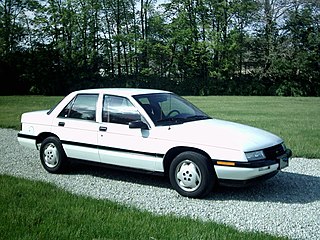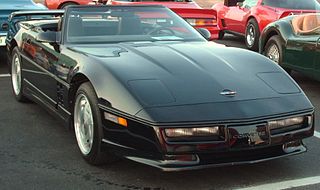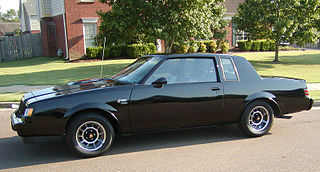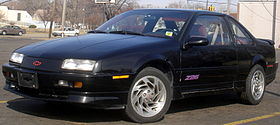
Pontiac, or formally the Pontiac Motor Division of General Motors, was an American automobile brand owned, manufactured, and commercialized by General Motors. It was originally introduced as a companion make for GM's more expensive line of Oakland automobiles. Pontiac quickly overtook Oakland in popularity and supplanted its parent entirely by 1933, in turn establishing its position as one of GM's dominant divisions.

The Pontiac Sunbird is a model line that was manufactured and marketed by Pontiac from the 1976 to the 1994 model years. Loosely deriving its name from the Pontiac Firebird, the Sunbird was introduced as the eventual replacement for the Pontiac Astre, replacing it entirely in 1978 as the smallest Pontiac.

The Chevrolet Corsica is a front-wheel drive compact car that was produced by Chevrolet from 1987 until 1996. The Corsica was built upon the L-body platform. It shared the L-body with the 2-door Beretta, and the rebadged revival of the Pontiac Tempest which was essentially the same car, but was only sold in Canada and Middle East. The Corsica came in two styles and four trims. Sold initially only as a 4-door sedan, it was also available as a 5-door hatchback from model years 1989 until 1991. Corsicas were built alongside the Beretta by both the Wilmington Assembly in Delaware and Linden Assembly in New Jersey.

The Chevrolet Celebrity is a front-drive, mid-size passenger car line, manufactured and marketed by Chevrolet for model years 1982–1990, over a single generation.

The Chevrolet Cavalier is a line of compact cars produced by Chevrolet. Serving as the replacement of the Chevrolet Monza, the Cavalier was the second Chevrolet model line to adopt front-wheel drive. Three versions of the Cavalier have been sold, including three generations sold in North America from model years 1982 to 2005, a version produced by SAIC-GM for China from 2016 to 2021, and a SAIC-GM version produced for Mexico since the 2019 model year.

The Tempest is an automobile that was produced by Pontiac from 1960 to 1970, and again from 1987 to 1991.

The Y platform, or Y body, designation has been used twice by the General Motors Corporation to describe a series of vehicles all built on the same basic body and sharing many parts and characteristics. The first was for a group of entry-level compacts including the conventional front-engine compacts built by GM divisions Buick, Oldsmobile and Pontiac from 1961 to 1963. The second, and current, incarnation is used for a high-end rear-wheel drive sports-car platform from the 1970s through the 2000s.

The General Motors 60° V6 engine family is a series of 60° V6 engines produced for both longitudinal and transverse applications. All of these engines are 12-valve cam-in-block or overhead valve engines, except for the LQ1 which uses 24 valves driven by dual overhead cams. These engines vary in displacement between 2.8 and 3.4 litres and have a cast-iron block and either cast-iron or aluminum heads. Production of these engines began in 1980 and ended in 2005 in the U.S., with production continued in China until 2010. This engine family was the basis for the GM High Value engine family. These engines have also been referred to as the X engines as they were first used in the X-body cars.

The Chevrolet Citation is a range of compact cars that was produced by Chevrolet from the 1980 to 1985 model years. The first front-wheel drive Chevrolet, the Citation replaced the Chevrolet Nova as the automaker downsized its compact cars. Initially slotted between the Chevrolet Monza and the Chevrolet Malibu in the Chevrolet product line, the model line was later marketed between the Chevrolet Cavalier and the Chevrolet Celebrity.

The Pontiac Trans Sport is a minivan that was marketed by Pontiac from the 1990 to 1999 model years. The first minivan marketed by the division, the Trans Sport marked the beginning of a wider transition of moving away from sedans and station wagons as family-oriented vehicles. Marketed between the Chevrolet Lumina APV and the Oldsmobile Silhouette took its name from a similar 1986 concept vehicle.

The Chevrolet Lumina APV is a minivan that was produced by the Chevrolet division of General Motors. Launched as the first front-wheel drive minivan sold by Chevrolet, the Lumina APV was sold in a single generation from the 1990 to 1996 model years. Marketed alongside the Pontiac Trans Sport and Oldsmobile Silhouette, the Lumina APV competed against the Dodge Grand Caravan/Plymouth Grand Voyager, the extended-length Ford Aerostar, and the Mazda MPV.

The Chevrolet Beretta is a coupé that was produced by Chevrolet from 1987 until 1996. Alongside the four-door Chevrolet Corsica, the Beretta served as the successor to the Chevrolet Citation. Slotted between the Cavalier and Lumina/Monte Carlo coupes, the Beretta was distinguished by its vertical door handles mounted on the B-pillar, a design feature later used by the Chevrolet Lumina coupe and its GM W-body counterparts.

The General Motors N platform was a front-wheel drive compact automotive platform produced from 1984 to 2005. The GM N platform was based on the GM J-Body and replaced the GM X platform.

The Pontiac Phoenix was a compact car that was sold from 1977 to 1984 by Pontiac. There were two generations of the Phoenix, both based on popular Chevrolet models, and both using the GM X platform designation. It was named for the mythological Phoenix, which would die in a self-inflicted fire and be reborn from the ashes. The Phoenix was replaced by the Grand Am in 1985.

The B platform is a full-size, rear-wheel drive, body-on-frame car platform, that was produced by General Motors (GM) from 1926 to 1996. Originally made for Oldsmobile and Buick, all of General Motors's five main passenger car makes would use it at some point. It was closely related to the original rear-wheel drive C and D platforms, and was used for convertibles, hardtops, coupes, sedans, and station wagons. With approximately 12,960,000 units built, divided across four marques, the 1965–1970 B platform is the fourth best selling automobile platform in history after the Volkswagen Beetle, Ford Model T, and the Fiat 124.

The 122 engine was designed by Chevrolet and was used in a wide array of General Motors vehicles. The 122 was similar to the first two generations of the General Motors 60° V6 engine; sharing cylinder bore diameters and some parts. The 122 was available in the U.S. beginning in 1982 for the GM J platform compact cars and S-series trucks.

The Pontiac Grand Am is a car model that Pontiac Division of General Motors produced in various years between 1973 and 2005. The first and second generations were RWD mid-size cars built on the LeMans GM A platform. The Grand Am name was reused for a FWD compact car for the third- and fourth-generations. The fifth-generation versions was enlarged to a mid-size car.

The General Motors G platform was an automobile platform designation used for mid-sized rear-wheel drive cars. It made its first appearance from the 1969 to 1972 model years, adapted from GM's A-body, and reappeared from 1982 to 1988. The second series of G-bodies began production designated as A-body cars in 1978, but were redesignated as G-body when the new front-wheel drive A-body platform was introduced in 1982.
The GM A platform was a rear wheel drive automobile platform designation used by General Motors from 1925 until 1959, and again from 1964 to 1981. In 1982, GM introduced a new front wheel drive A platform, and existing intermediate rear wheel drive products were redesignated as G-bodies.

The General Motors X platform is a rear-wheel drive compact car automobile platform produced from the 1962 to 1979 model years. Developed by Chevrolet, the architecture was initially unique in the U.S. to the Chevy II, first joined by the Pontiac Ventura in 1971, then a range of other GM products as its divisions expanded their compact model lines.



















